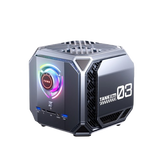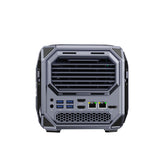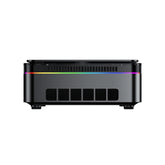Mini PC vs Mini ITX: Compact Computing Solutions Compared

Mini PCs and Mini ITX systems have increasingly caught the public's eye due to their compact size and robust capabilities, becoming a focal point for many users. But what exactly are Mini PCs and Mini ITX systems? What features and advantages do each offer? When faced with these two types of compact computing devices, should you opt for the hassle-free Mini PC or the customizable Mini ITX system? This article will delve into the concepts and characteristics of both, helping you make a wise choice between Mini PC and Mini ITX.
What is a Mini PC?
A Mini PC, or miniature personal computer, is a pre-assembled ultra-small computer. Compared to traditional desktops, Mini PCs are extremely compact, often fitting in the palm of your hand, yet they integrate all the main hardware components necessary for computing tasks. Their highly integrated design means that users can simply plug and play right after purchase, enjoying full computer functionality. This convenience makes Mini PCs an ideal choice for those seeking simple, efficient solutions.
Recommended Reading: Mini PC vs. Traditional Desktop: Which Is Right for You
What is Mini ITX?
Mini ITX is a small motherboard format measuring 17 cm x 17 cm, first introduced by VIA Technologies in 2001. As one of the smallest standardized motherboards available, the advent of Mini ITX has made it possible to assemble compact custom computers. Despite its small size, it retains the core functionalities of a desktop motherboard, such as CPU sockets, memory slots, and PCIe expansion slots. This means you can build a powerful computer within a compact case, meeting the needs of users who require both performance and space efficiency.
In-depth Comparison: Mini PC vs Mini ITX
Difference 1: Size and Portability
In terms of size and portability, Mini PCs have a clear advantage. Designed for ultimate miniaturization, Mini PCs are usually palm-sized, lightweight, and easy to carry in a backpack or pocket. In contrast, Mini ITX systems, while more compact than traditional desktops, are limited by the size of components like graphics cards, power supplies, and coolers. They typically require a small case to house all parts, making them less portable than Mini PCs.
Difference 2: Performance
Performance-wise, Mini ITX systems have the upper hand. Since you can choose high-performance processors, memory, storage, and discrete graphics cards, Mini ITX systems can match or even exceed the capabilities of full-sized desktops, suitable for heavy tasks like gaming, video editing, and 3D rendering. On the other hand, Mini PCs, due to size and cooling constraints, often use low-power mobile processors and integrated graphics, making them suitable for everyday office work, multimedia playback, and light applications.
Difference 3: Customizability and Upgradability
Mini ITX systems excel in customizability and upgradability. Users can freely select and replace hardware components, such as upgrading the processor, adding memory, or swapping in more powerful graphics cards, offering greater expansion and upgrade potential. However, Mini PCs, due to their highly integrated design, have limited internal space and typically have hardware soldered onto the motherboard, making them difficult to customize or upgrade.
Difference 4: Price
Price-wise, Mini PCs generally have a lower initial cost compared to Mini ITX systems, especially at entry-level configurations, offering an economical solution. However, considering long-term usage costs, Mini ITX systems, with their strong upgradability, allow users to gradually update components, potentially offering better cost-effectiveness over time. Conversely, building a high-performance Mini ITX system, especially with compact high-end components, can significantly increase initial expenses.
Difference 5: Application Suitability
While there are high-performance gaming Mini PCs available, most Mini PCs are better suited for everyday office tasks, web browsing, multimedia playback, light gaming, and educational purposes. Their compact and portable nature also suits users who need to move their devices frequently. Mini ITX systems are more appropriate for gamers, content creators, and professionals with higher performance needs, capable of supporting intensive tasks like large-scale gaming, video editing, and 3D modeling. Depending on your specific usage requirements, you can choose the device type that best fits your needs.
How to Choose the Right Option for You
Clarify Your Needs
Firstly, it's crucial to clearly understand your main purposes and performance requirements. If your daily work mainly involves using office software, browsing the web, and streaming media, which are not highly demanding tasks, then a compact, easy-to-operate Mini PC might be your ideal choice. It meets basic computing needs while saving space. If you are a gamer, content creator, or need to run complex software and perform high-performance computing, a Mini ITX system would be more suitable. It allows for high-end processors, discrete graphics cards, and ample memory, providing performance comparable to full-sized desktops.
Consider Your Budget
Before making a decision, evaluating your total budget, including potential future upgrade costs, is wise. Mini PCs typically have a lower initial cost, suitable for users with limited budgets and moderate performance needs. However, their limited upgrade space means that enhancing performance might require replacing the entire machine. Mini ITX systems might require a higher initial investment, especially when choosing high-performance components, but their excellent upgradability allows you to gradually upgrade hardware, extending the system's lifespan and potentially offering better long-term value.
Assess Your Technical Skills
Considering your technical skills and interest in computer hardware is also important. If you lack experience in assembling computers or prefer not to spend time on hardware configuration and maintenance, then the plug-and-play Mini PC offers great convenience, requiring no assembly. If you have a keen interest in hardware, enjoy the assembly and tuning process, and possess some technical knowledge, then a Mini ITX system will meet your needs. You can choose your components to build a computer that perfectly suits your preferences while enjoying the DIY process.
Space and Aesthetics
Finally, consider your preferences for device appearance and space occupation. Mini PCs, with their ultra-small size and simple design, fit well in limited spaces like small desks or living room TV cabinets, and are easy to conceal or place without taking up much space. If you desire a computer with a unique appearance or have specific requirements for the case's design and lighting effects, Mini ITX systems offer more options. Although slightly larger than Mini PCs, they still maintain a compact size while balancing aesthetics and performance.
By considering your needs, budget, technical skills, and preferences for space and aesthetics, you can make the best choice between a Mini PC and a Mini ITX system. Whether you opt for the simplicity and convenience of a Mini PC or the performance and customization of a Mini ITX system, both can meet your needs in various scenarios. This blog's analysis aims to assist you in making an informed decision and finding the computing solution that best fits your requirements.
Real-World Examples and Recommendations
The market is filled with excellent Mini PC options, but ACEMAGIC's Mini PC stands out for its exceptional performance and high cost-effectiveness. Equipped with mainstream processors like Intel or AMD's low-power series, ACEMAGIC's Mini PC offers ample memory and high-speed SSD storage. This configuration meets the demands of daily office tasks, multimedia entertainment, and light creative work. Its compact design not only saves space but also features a stylish appearance, making it suitable for placement in living rooms, studies, or offices.
ACEMAGIC AMR5 AMD Ryzen 7 Mini PC

- The Acemagic AMR5 is a high-performance mini PC equipped with an AMD Ryzen™ 7 5700U processor (up to 4.3GHz), supporting up to 64GB of DDR4 memory and 2TB of NVMe SSD. It offers multiple 4K video output options, supports WiFi 6 and Bluetooth 5.2, runs on Windows 11, and has a compact size of 132.9mm x 156.1mm x 71.8mm.
When assembling a Mini ITX system, consider these points for optimal performance: Ensure component compatibility to avoid installation issues, focus on effective heat dissipation and airflow due to limited space, manage cables neatly to improve both aesthetics and airflow, and choose low-power components to enhance energy efficiency.
Extended reading: Mini PC vs Mini ITX price for performance - Reddit
Conclusion
After a thorough comparison and analysis, it's clear that both Mini PC and Mini ITX systems offer distinct advantages and are suitable for different user needs.
The primary strengths of a Mini PC lie in its ultra-compact size and plug-and-play convenience. It occupies minimal space, consumes less power, and operates with simplicity—no assembly or technical expertise required. This makes it ideal for users who need quick deployment and wish to save space. For scenarios that don't demand high performance—such as daily office work, web browsing, multimedia entertainment, and educational purposes—a Mini PC provides an economical and efficient solution. However, its limited expandability and upgrade potential make it less suited for high-performance applications or future hardware upgrades.
In contrast, the Mini ITX system shines with its high degree of customization and robust performance. By selecting hardware components themselves, users can build a compact PC that rivals full-sized desktops in performance, capable of handling games, video editing, 3D rendering, and other intensive tasks. The strong upgradability of Mini ITX systems allows for hardware enhancements down the line, improving performance as needed. Nevertheless, assembling a Mini ITX system requires a certain level of technical knowledge and time investment. The initial cost may be higher, and its size, while compact, is slightly larger than that of a Mini PC.
Recommendations:
-
If you value simplicity and convenience, primarily use your computer for basic applications like daily office tasks, web browsing, and media consumption, and wish to save space and money, then a Mini PC is your ideal choice. It's ready to use out of the box and meets your basic computing needs.
-
If you require higher performance, desire the freedom to customize hardware configurations, and possess some technical expertise, then a Mini ITX system is better suited to you. It not only delivers powerful performance but also allows you to create a unique PC tailored to your preferences, with excellent upgrade potential.
Ultimately, choosing the right solution involves weighing your specific use cases, budget constraints, technical skills, and preferences regarding device appearance and space occupation. Whether you opt for a Mini PC or a Mini ITX system, both offer satisfying experiences in a compact form factor. We hope this blog post assists you in making an informed decision and helps you find the computing solution that best fits your needs.
FAQs
1. Why is Mini-ITX more expensive?
Mini-ITX systems are often more expensive because they require specialized, compact components that generally cost more than standard-sized parts. Components like small form-factor power supplies, miniaturized graphics cards, and compact cooling solutions are designed to fit into the limited space of a Mini-ITX case, which drives up their production costs. Additionally, the demand for high-performance parts in a smaller size leads manufacturers to invest in advanced engineering and materials, further increasing prices. The customization and flexibility of building a Mini-ITX PC also mean that users may opt for higher-end components to maximize performance in a compact build, contributing to the overall higher cost compared to pre-built Mini PCs.
2. What are the cons of a Mini-ITX PC?
The cons of a Mini-ITX PC include a higher level of assembly complexity, as fitting components into a small case requires careful planning and technical expertise. The limited space can lead to challenges with heat management, making effective cooling solutions both essential and sometimes costly. Mini-ITX components, such as motherboards and power supplies, are often more expensive than their standard-sized counterparts due to their specialized design. Additionally, there may be fewer expansion slots and ports available, limiting future upgrade options.
3. Is Mini-ITX or Mini PC better for me?
Choosing between a Mini-ITX and a Mini PC depends on your specific needs and preferences. If you prioritize simplicity, compactness, and ease of use for everyday tasks like web browsing, office applications, and media playback, a Mini PC is the better choice. It's a plug-and-play solution that's cost-effective and saves space. However, if you require higher performance for gaming, content creation, or professional software, and you have the technical skills or interest in building and customizing your system, a Mini-ITX PC would be more suitable. It offers greater flexibility in component selection and the potential for upgrades, albeit with a higher initial cost and a slightly larger form factor.
Related Article
Mini PC vs Stick PC Comparison: How to Choose the Best Portable Device
Mini PC vs SFF PC: Compact Desktop Computer Comparison
Mini PC vs All-in-One (AiO) PC: Which One Is Right for You?
Enhancing ACEMAGIC AMR5 Mini PC Performance with an External GPU
Mini PC vs. Traditional Desktop: Which Is Right for You
Raspberry Pi 5 vs Mini PC: Your Guide to Choosing the Right Device
Dual NIC vs Single NIC Mini PCs: Is a Dual-NIC Mini PC better?







Leave a comment
Please note, comments need to be approved before they are published.